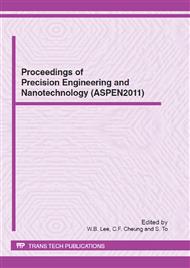p.181
p.186
p.192
p.198
p.203
p.209
p.215
p.222
p.228
Study on Thermal and Strain Behaviour in Selective Laser Sintering Process
Abstract:
This paper investigates thermal and strain behaviour in the selective laser sintering process with a mixture of SCM, Cu and Ni metal powder. In-process monitoring of strain change and temperature at the base plate is proposed in order to investigate thermal and strain behaviour induced by selective laser sintering. A strain gauge was attached to the bottom surface of the base plate while a thermocouple was inserted at a distance of 2 mm from the top surface of the base plate. Changes in the strain and the base plate temperature were observed using an oscilloscope during the laser sintering process. The results showed that the development of strain within the sintered structure was affected by the processing temperature. Besides that, after the laser sintering process was completed, the strain value increased gradually and became constant as it reached room temperature. This strain value was found to correspond with the test models deformation. In addition, the effects of laser scanning direction and laser energy density during the process were observed. Measurement of the test models deformation was also carried out to discover its relationships to strain change and processing temperature. The results showed that the sintered structure produced by laser scanning of a sector along the width induced less residual strain, which resulted in less deformation. In contrast, both residual strain and deformation were found to be higher when the laser scanning was carried out along the length. Furthermore, when a low laser energy density was used, less deformation of the sintered structure could also be obtained.
Info:
Periodical:
Pages:
203-208
Citation:
Online since:
June 2012
Price:
Сopyright:
© 2012 Trans Tech Publications Ltd. All Rights Reserved
Share:
Citation:


